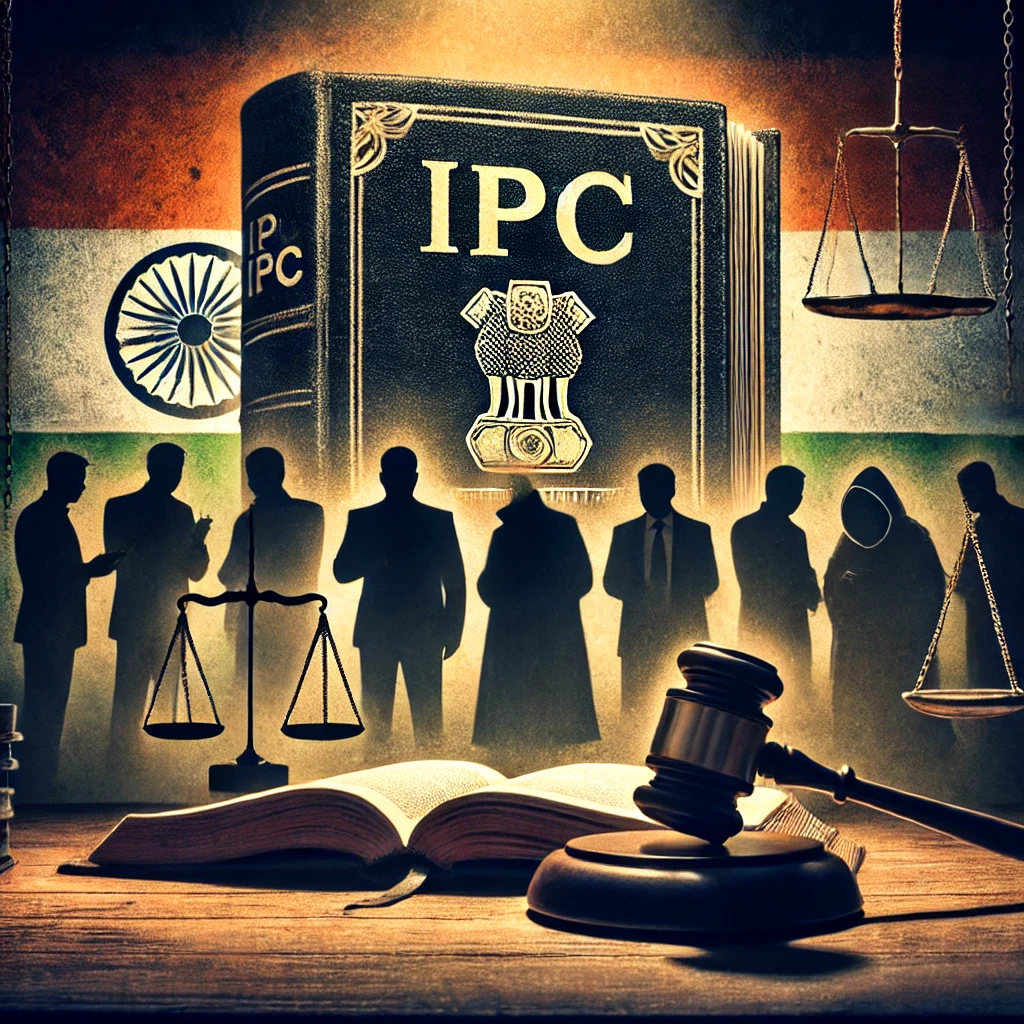
This article has been written by Parinitha, a 5th year BCOM LLB Student from St Joseph’s College of Law, Bengaluru.
Abstract
Criminal conspiracy is an important offense under the Indian Penal Code wherein its regulatory provisions are found within Sections 120A and 120B. The criminal conspiracy has evolved as an independent offense since 1913 and represents a change in criminal jurisprudence. It deals with the unlawful partnership between two or more persons in the performance of an illegal act or a lawful act by unlawful means. This legal analysis explains the history, definition, elements, and punishment of criminal conspiracy under the IPC, discussing the differences between conspiracy and abetment and how Indian courts have interpreted criminal conspiracy.
Several landmark judgments such as Esher Singh v. State of Andhra Pradesh and Major E.G. As this case Baray v. The state of Bombay threw light on the dubious circumstances of conspiracy which required an agreement and the intent amongst two or more individuals. Second, the article compares Sections 120A and 34 of the IPC which creates intra and inter-conceptual legal analysis relating to the implications of these sections in Criminal law.
The discussion also touches on the challenges of proof in conspiracy, which are its inchoate state and the risks of abuse. It concludes by making recommendations as to how the judiciary can ensure that the law on conspiracy is properly applied while avoiding unjust prosecutions.
KEYWORDS: Indian Penal Code, Criminal Conspiracy, Punishment, 120A, 120B
Introduction
Criminal conspiracy is the point of intersection of thought and action in criminal law. Unlike most other crimes under the IPC, which have based their jurisprudence upon acts only, conspiracy criminalizes mere agreement or intent to commit a criminal act without regard for whether the crime contemplated has been consummated. This legal concept that founded crime prevention at inception was not originally included in the IPC but was brought into the statute book by amendment in 1913. Sections 120A and 120B now deal exclusively with criminal conspiracy, distinguishing it from other offenses such as abetment and joint liability under Section 34.
The element of conspiracy remains an integral component of modern criminal law because it involves collective criminal intent and planning. In a world where it is mainly structured organized crime, terrorism, and large-scale financial frauds require very intricate conspiracies, the law on conspiracy itself becomes a preventive element. However, due to its comprehensive scope and scope for abuse, the judiciary has been a powerful tool in interpreting and practicing it; right from protecting the accused people’s rights to punishing those conspiring to commit illegal acts.
In this article, the criminal conspiracy mechanism under the IPC will be discussed in light of its constituent elements, punishment, and case illustrations from the judiciary, comparing several landmark judgments. Finally, the article will also discuss different aspects of sections in the IPC related to conspiracy, abetment, and joint liability.
Historical Background
Lord Macaulay drafted the IPC in 1860, wherein no special provisions for this offense existed at the time. The only related provision at that time was that of abetment by conspiracy as defined in Section 107 of the IPC. However, such a provision was felt to be quite inadequate because it did not punish mere agreements to commit a crime unless an overt act had been committed. Recognizing the above limitations of Section 107, the Indian Legislature introduced Chapter VA in 1913, adding Sections 120A and 120B by which a conspiracy has been now criminalized as an independent offense.[1]
These sections are influenced by the British legal system. The offense of conspiracy has been there for a long time in the British legal system. These provisions are incorporated to control the growing rate of organized crimes and illegal agreements between individuals by the lawmakers of India.
Definition of Criminal Conspiracy under the IPC
Definition of criminal conspiracy Section 120A defines criminal conspiracy as: “An agreement between two or more persons for the doing of an illegal act, or an unlawful act by illegal means”. [2]The section specifically clarifies that an offense of conspiracy is constituted even if no illegal act is ever done. It marks a departure from considering criminal liability as being directed to the doing of an illegal act, to the formation of a criminal intent.
For an act to be held as a criminal conspiracy, there must be satisfaction of three main ingredients under Section 120A of the Indian Penal Code, namely[3]:
- Agreement Between Two or More Persons: Criminal conspiracy cannot exist if there is one person only. There must be an agreement of at least two persons. The agreement can be oral or even inferred from the actions or conduct of individuals involved.
- Contract to Commit an Illegal Act or a Lawful Act by Wrongful Means: The contract must be made with the intention of committing an illegal act. The act might be something in itself illegal, such as stealing, or it might be an act that is in itself legal but carried out by wrongful means, like getting possession of property on the basis of fraud.
- Commission of an Over Act in Some Cases: In conspiracy to commit petty offenses, a commission of an overt act in furtherance of a conspiracy is essential to infer the offense. However, in cases of serious offenses such as murder or robbery, the conspiracy itself is held to amount to the offense.
Section 120B[4]
Section 120B of the IPC deals with the punishment for criminal conspiracy. The section makes a distinction between two kinds of conspiracies:
- Conspiracies to Commit Grave Offences: In case the said offense is punishable with death, life imprisonment, or imprisonment for a term of two years or upwards, the punishment for the conspiracy shall be dealt with the same as would have been given on a conviction for abetment of such offense.
- Conspiracies to Commit Lesser Offences: Where the conspiracy is for committing any other offense, the imprisonment shall not exceed six months, or a fine, or both.
Legal Analysis
The very need for a conspiracy between two or more persons brings problems in the administration of justice where one or more conspirators are pardoned, absconded, or are otherwise beyond the reach of law. There have been judgments from the courts which hold that a conspiracy continues to subsist as long as the agreement continues to subsist, and a single conspirator can be held liable if that person is the last remaining member of a conspiracy. This doctrine, however, raises a whole host of questions as to whether such a person could be capable of defending himself when co-conspirators are out of evidence or have absconded from the jurisdiction.
The word ‘agreement’ is very technical in the conspiracy. There is rarely explicit agreement; on the contrary, courts usually deduce the existence of conspiracy from circumstantial evidence such as the coordinated activity of the alleged conspirators. This gives rise to important questions about the standard of proof. The courts have held that the circumstantial evidence must be of such a quality that it leaves no other reasonable explanation except the existence of a conspiracy. In Major E.G. Barsay v. The State of Bombay[5], there again reiteration was made that the evidence of an agreement is not direct. An overt act, born out of some tacit understanding, could suffice. However, there must be compelling and conclusive evidence.
The requirement of an overt act ensures a further safeguard against the grossly wide criminalization of agreements that may never be acted upon. But in serious cases, that safety does not exist. Critics point out that when such cases are without a necessity for an overt act, wrongful convictions are all the more likely to occur when the evidence of an agreement is entirely circumstantial. This balance between public safety and the protection of individual rights has been one of the most disputed issues in the conspiracy law.
Section 120A versus Section 34: A Comparative Analysis of the Law
One distinction that needs to be understood from conspiracy law under the IPC is to distinguish it with joint liability under Section 34. Here, Section 34 speaks of acts done by several persons in furtherance of a common intention. Section 120A talks about conspiracy, though it addresses collective criminal action like the former, this provision differs considerably in its legal requisites and consequences from the former.
Section 34 requires active participation in the criminal act. The section applies when a criminal act is carried out by several persons in furtherance of a common intention. In contrast, under Section 120A, mere agreement will be enough for criminal liability without there being any criminal act at all.
The courts have held that, under Section 34, all co-accused must have contributed to the commission of the crime[6]. Such a requirement sets a much higher standard of proof of a conviction under a section as compared to Section 120A, where intent and agreement would suffice. The basic difference makes conspiracy much more versatile as a legal tool for law enforcement but casts serious doubts about misuse.
Section 34 lays down that at the time of the commission of the offense, there should be a common intention among the offenders. Whereas, in a conspiracy under Section 120A no such inference is drawn that the offense has to be committed. The criminal intent is liable for the commission of an offense.
This ingredient of common intention under Section 34 brings into the case an important limitation- only the parties to whom the intent to commit the act is common can be held liable. In contrast, compared with the position under Section 120A where those who were peripheral to the agreement but did not participate in the offense could even be convicted, the position here is very different. The problem with conspiracy cases is that individuals are held liable for simply being part of an alleged agreement even though they may have played a minor role or only an indirect role in the alleged agreement.
Judicial Interpretation and Landmark Cases
Time has ripened the Indian courts and has provided a treasure trove of case law on the criminal conspiracy provisions. Many significant judgments have cleared various aspects of conspiracy law, starting from the requirement of an overt act, and admissibility of evidence, to distinguishing between conspiracy and abetment.
- Esher Singh v. State of Andhra Pradesh (2004)[7]: The Supreme Court in this judgment held that the essence of criminal conspiracy provisions is to prevent the undue power that a group of individuals may gain by forming an agreement to commit illegal acts. In its ruling, the court held that even though an individual may not be able to commit the crime by himself, it is the setting up of others with him in a conspiracy that provides the needed support to execute the illegal act.
- 2. Tapan Das v. State of Bombay (1955)[8]: The main question in this case was whether a lone person could be convicted of criminal conspiracy. It was observed that even though a single individual could not be convicted on the grounds of conspiracy, there were exceptions where pardon, absconding, or withdrawal from prosecution took place.
- Major E.G. Barsay v. The State of Bombay (1962)[9]: In this case also, the judgment dealt with the conspiracy’s conspirators. It was held by the court that one need not participate in every act of conspiracy to attract criminal liability. A person who plays an active role in helping forward the conspiracy can be held liable for the entire conspiracy though he has not participated in every criminal act.
- Saju v. State of Kerala (2000)[10]: The Supreme Court of this case went on to emphasize that criminal conspiracy is an inchoate offense. The court held that it is irrelevant whether the ultimate object of the conspiracy was achieved. The mere agreement to commit an illegal act is sufficient to constitute the offense of conspiracy.
Section 10 of the Indian Evidence Act, 1872[11]
Indian Evidence Act addresses the admissibility of evidence in conspiracy cases. Section 10 of the Indian Evidence Act ensures that anything said, done, or written by one conspirator in furtherance of the conspiracy is held to be admissible against all conspirators. But before such evidence can be admitted, there are several conditions precedent to be satisfied like proof of two or more persons agreeing to do or cause to do something to commit an offence.
Critical Analysis of Criminal Conspiracy under the Indian Penal Code
While provisions under the IPC relating to criminal conspiracy aim to address the collective intent to commit crimes, broad language and pliable evidentiary standards inherent in these provisions have always been viewed with suspicion for possible misuse. Criticisms are mainly that conspiracy laws may be used to get people convicted on suspicion or mere circumstantial evidence rather than conviction based on concrete proof of involvement in an offense. It is badly problematic for politically sensitive cases, because otherwise well-founded conspiracy charges may be leveled against individuals or groups in a situation to stifle dissent.
As law accepts circumstantial evidence to prove a conspiracy, courts have consistently underscored that it ought to be of the compelling type. In any event, the possibility of condemnation based upon weak or even speculative evidence is always there, especially in those scenarios where prosecution’s cases rely on indefinite or even ambiguous communications between the accused.
The essential problem with circumstantial evidence is its tendency to cause a violation of the due process rights of the accused if wrongly applied to convict a person based upon minor inferences. As for the initial purpose of establishing stringent standards that would control their admissibility in courts, the general character and reach of conspiracy laws dispel an early postulated belief of the significant possibility of uniform results.
Conspiracy laws have long been criticized as potential tools of abuse, particularly where political or social activism is involved. The breadth of the definition of conspiracy and the relatively low evidentiary threshold to prove an agreement makes it quite easy for police to target individuals or groups based on what they believe may happen rather than what has occurred.
An issue becomes germane with such a trend in recent years when conspiracy charges are tossed about in prominent cases dealing with protests or dissent against the government. Being used after there is occasional judicial interference to prevent this misuse in itself remains and is, of course, a cause for concern, given the political as well as social context in which it is applied.
Indian courts have been very careful while applying charges of conspiracy, keeping an emphasis on a satisfactory level of evidence regarding an agreement and intent. However, there have been instances when these laws were applied too loosely and brought in claims of infringement of due process and fundamental rights.
Legal scrutiny of the charges brought by the prosecution, in particular by the judiciary, over conspiracy is very important, especially when it appears circumstantial or based on speculative inferences. The courts have to provide a balance between public safety and that of the accused, especially with matters like this involving very sensitive political issues.
Conclusion
The offense of criminal conspiracy under the IPC is a vital tool in addressing collective criminal behavior, but it comes with significant legal and ethical challenges. The broad language of Sections 120A and 120B, coupled with the reliance on circumstantial evidence, makes conspiracy a complex and potentially problematic offense. While the law is designed to prevent criminal intent from translating into harmful actions, its inchoate nature raises concerns about potential misuse.
Indian courts have played a crucial role in interpreting conspiracy laws, setting standards for evidence, and ensuring that the rights of the accused are protected. However, there is a need for continued judicial scrutiny to prevent the wrongful application of conspiracy laws and to ensure that individuals are acquitted based on mere speculation or weak evidence. As we advance, the judiciary must strike a careful balance between upholding public safety and safeguarding individual rights, particularly in cases involving circumstantial evidence and politically sensitive issues.
The law of conspiracy is a necessary part of the criminal justice system, but its application must be tempered by caution, fairness, and a commitment to the rule of law.
[1] KD Gaur, Textbook on Indian Penal Code (6th Edn)
[2] The Indian Penal Code, 1860 Act No. 45 of 1860
[3] The Indian Penal Code, 1860 Act No. 45 of 1860
[4] The Indian Penal Code, 1860 Act No. 45 of 1860
[5] AIR 1762, 1962 SCR (2) 195
[6] The Indian Penal Code, 1860 Act No. 45 of 1860
[7] Appeal (crl.) 1363 of 2003
[8] AIR 33, 1955 SCR (5) 881
[9] AIR 1762, 1962 SCR (2) 195
[10] Appeal (crl.) 699 1998
[11] The Indian Penal Code, 1860 Act No. 45 of 1860







